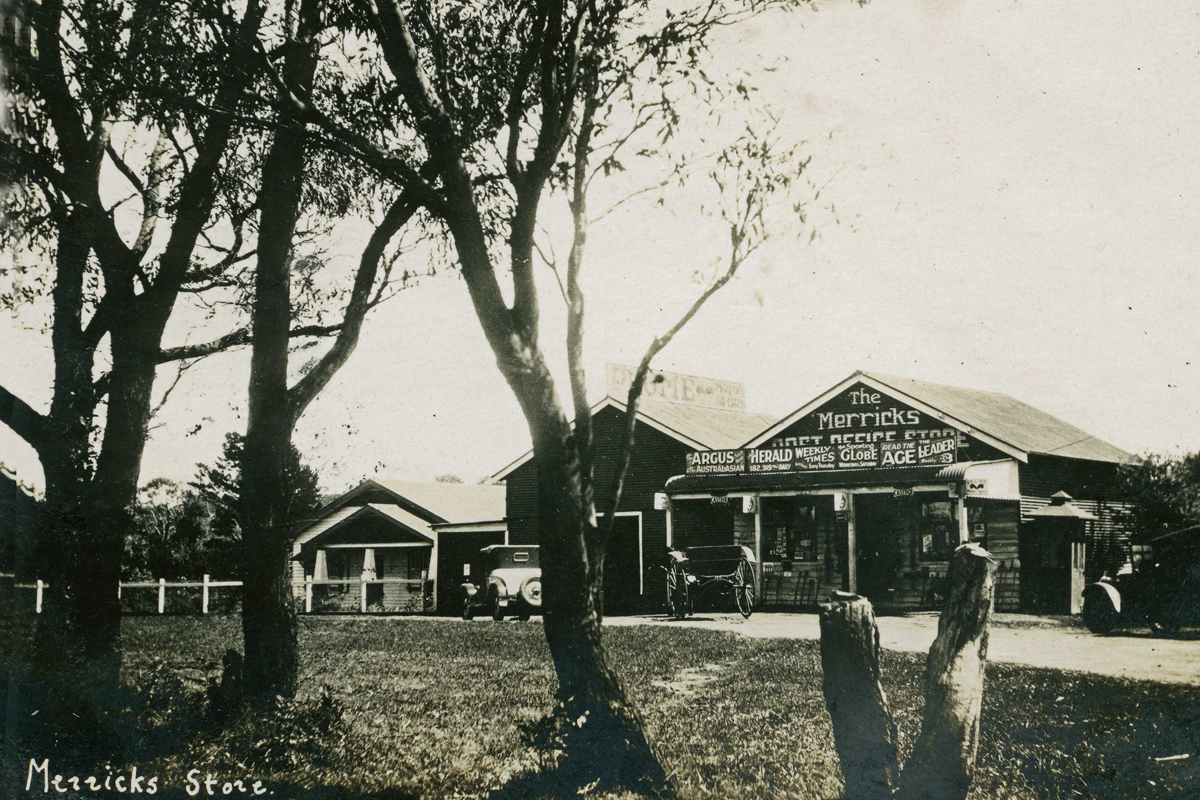
By Ilma Hackett, Balnarring and District Historical Society (BDHS)
It has an old-world charm with its verandah posts covered by vines, the wooden façade and walls of corrugated tin. Today’s Merricks General Wine Store is a well-known, well-patronized restaurant on the corner of Frankston- Flinders Road and Thompsons Lane. Its present appearance makes a marked contrast to the plain, weatherboard-fronted building that was erected a century ago as a general store for the surrounding farming community. In fact, the store was the fulfilment of a dream for a young engaged couple.
A dream takes shape
The store was built by Jack Joyner and his sons for Jack’s only daughter Tilly and her fiancé, Alf Weston. Tilly, a dark-haired, lively lass had grown up on the family farm at Merricks. After he gave up farming her father, a shipwright by trade, supplemented his income by working on the boat ramps at Crib Point while her mother, the district’s postmistress from 1919, ran the local post office from the front veranda of their home, ‘Marlowe’, in Merricks.Tilly and her friends attended the dances held at the naval base and it was here that she met Petty Officer Albert Edward Weston, known to everyone as Alf. A Queenslander, Alf joined the navy when he was sixteen and served throughout World War I on various ships. After the war he was stationed at the Flinders Naval Depot as a plumbing instructor. Romance blossomed, the two became engaged and planned their future. Alf bought land in the township of Merricks with the idea of setting up a store which the couple would run after he quit the navy. With this in mind he handed his pay into Tilly’s keeping so a building could be erected on the easternmost lot.
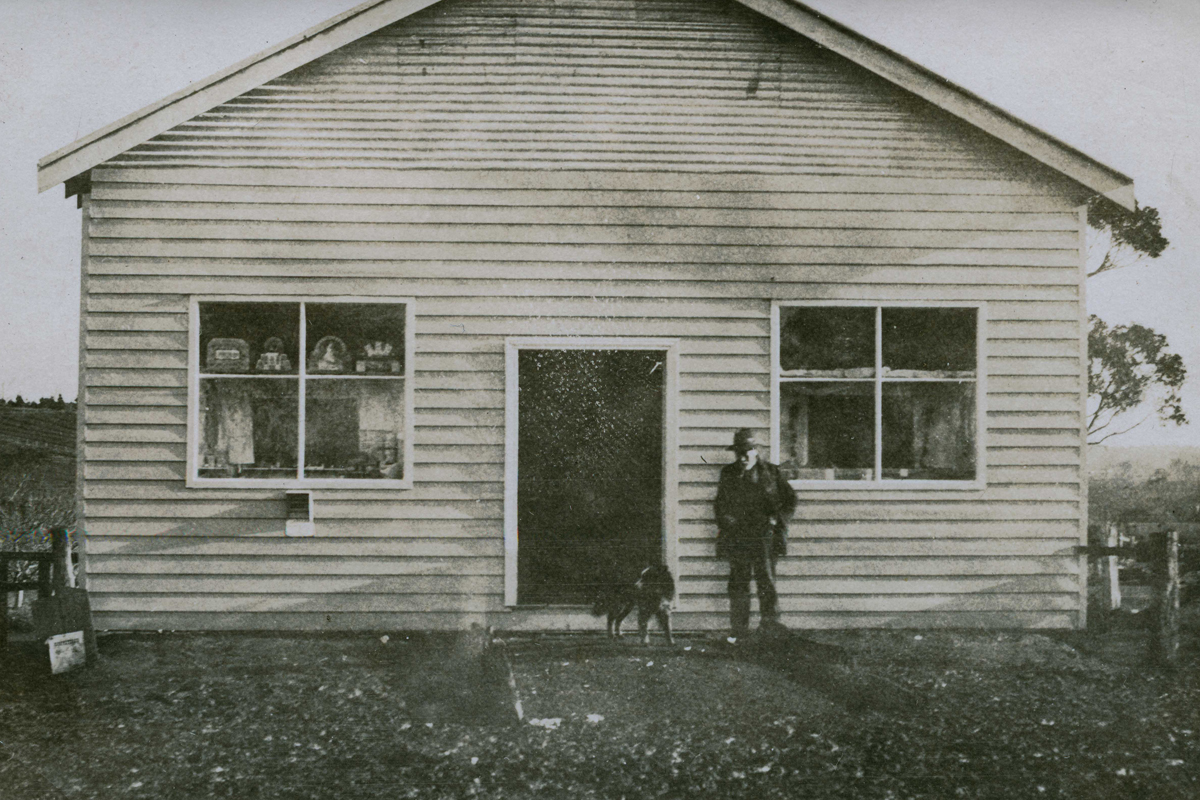
Merricks in the 1920s was predominantly a farming and grazing community. It had the post office, two small churches and, from 1921, a railway station on the Red Hill to Bittern line that linked with the Frankston line to Melbourne. The station was conveniently close to the store which at first sold farm produce. Then, in 1923 the post office was re-located to the newly opened general store with Mrs Joyner continuing as Post Mistress.
Alf was discharged in 1926 and he and Tilly married in St Mark’s Anglican Church, Balnarring on 5 June; ‘a very pretty wedding’ as the newspaper reported. A reception followed in the Balnarring Hall where family members and friends dined then danced to the music of the Jazz Band from the Naval Base. The new Mr and Mrs Weston left the following day for Queensland. As distance prevented Alf’s family from attending the wedding, he was taking his bride to meet them. During their absence Tilly’s brothers completed building the weatherboard, Californian-style bungalow on the land next to the store; “Westgate’ was ready when Tilly and Alf returned. In the corner of the garden nearest the store Tilly planted a kurrajong sapling she had carried back from Queensland. The little tree flourished to become the majestic tree that stands there today.

A thriving business and community hub
The Merricks Post Office Store did well. The building expanded as trade grew. The Westons endeavored to provide everything the community might need: horse shoes, chaff, boots, saddles, farm machinery, toys, groceries, kerosene lamps. As a small girl Elma Cole from ‘Seagrove’, opposite the store, remembers the packets of cigarettes displayed in the windows. “Each packet came with a give-away ring to wear on your finger. My father would buy cigarettes so I could have whichever ring I wanted”.
Some goods were provided from local sources, like the bread from Flinders, but most goods came from Melbourne sources. Alf drove his truck up to Melbourne and brought them back with him. He also ran a delivery round dropping orders off to farms around Shoreham, Merricks North and as far as Flinders. The store quickly became a hub where people met daily when they went to collect their mail and newspapers and to hear the latest local news.
A petrol pump with a wind-up handle was installed with petrol selling at 1/6 (one shilling and sixpence) per gallon. Henry Crowe recalls how he passed the store every day on his way to the Merricks school (which opened in 1926). “The ground was always greasy near the petrol pump which was at the Point Leo end of the building. The telephone box was at the other end”. The telephone switchboard handled local calls while outside calls went through the Flinders exchange. The mail came and went by car to the railway station. Tilly officially took over the Post Office in 1927 and in 1933 Alf was appointed assistant. The first of the couple’s sons, George, was born in 1927 and his brother, John in 1933. Both boys attended the nearby Merricks School, then later Padua and Brighton Grammar. The Westons employed young local people to help in the store and post office. Iris Ward, an orchardist’s daughter, worked there for a number of years and Sarah Crow worked the switchboard. School girl Jean Oswin worked in the store on a Saturday and became a full time assistant when she left school. To her embarrassment Alf teased her by singing romantic ditties.
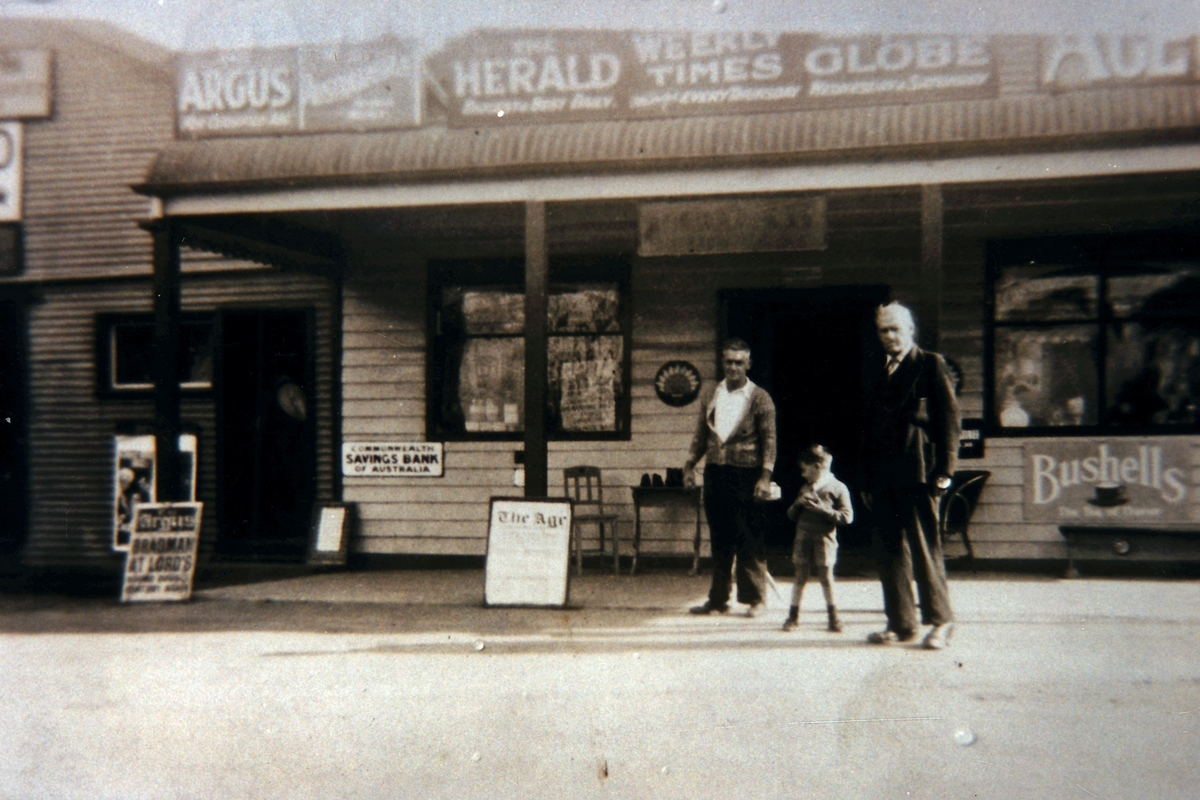
Alf and Tilly ran the business together for over twenty years. It was hard and heavy work and eventually took its toll on Alf who had a heart attack while at the switchboard. He died in the Hastings Hospital in 1944.
Tilly steps aside
Tilly continued to run the store for a time but in the 1950s her mother’s health declined. Tilly stepped aside to nurse her and leased the business. Over the following eight years a number of different people had charge of the post office/store. In 1957 it was run by Anne Braun and her husband, a navy man. They were succeeded the following year by Gordon and Pearl Baker. Pearl ran the post office while Gordon was in charge of the store’s deliveries. Unfortunately, Gordon’s ill health forced them to step back three years later and the post office passed to Stanley Gordon. He was in the store for about a year before it was taken over by Stan and Ann Wright, then passed back to Stanley Gordon. The frequent changeovers lead to a number of customers shopping elsewhere, especially those from the Flinders area.
In 1964 the McWhinney family became the new store keepers. Son Peter recalls, “the store included. . . a post office and Commonwealth Bank Agency. The post office catered to residents in the area who collected their mail from pigeon holes within the post office section of the building. Mail was delivered [to the store] by the postman at 5.00 p.m”. Ken McWhinney delivered the groceries in the family’s EH Holden station wagon. His round began with the three customers in Point Leo – the ranger and an elderly couple – then on to households in Merricks North as far as Foxey’s Hangout.
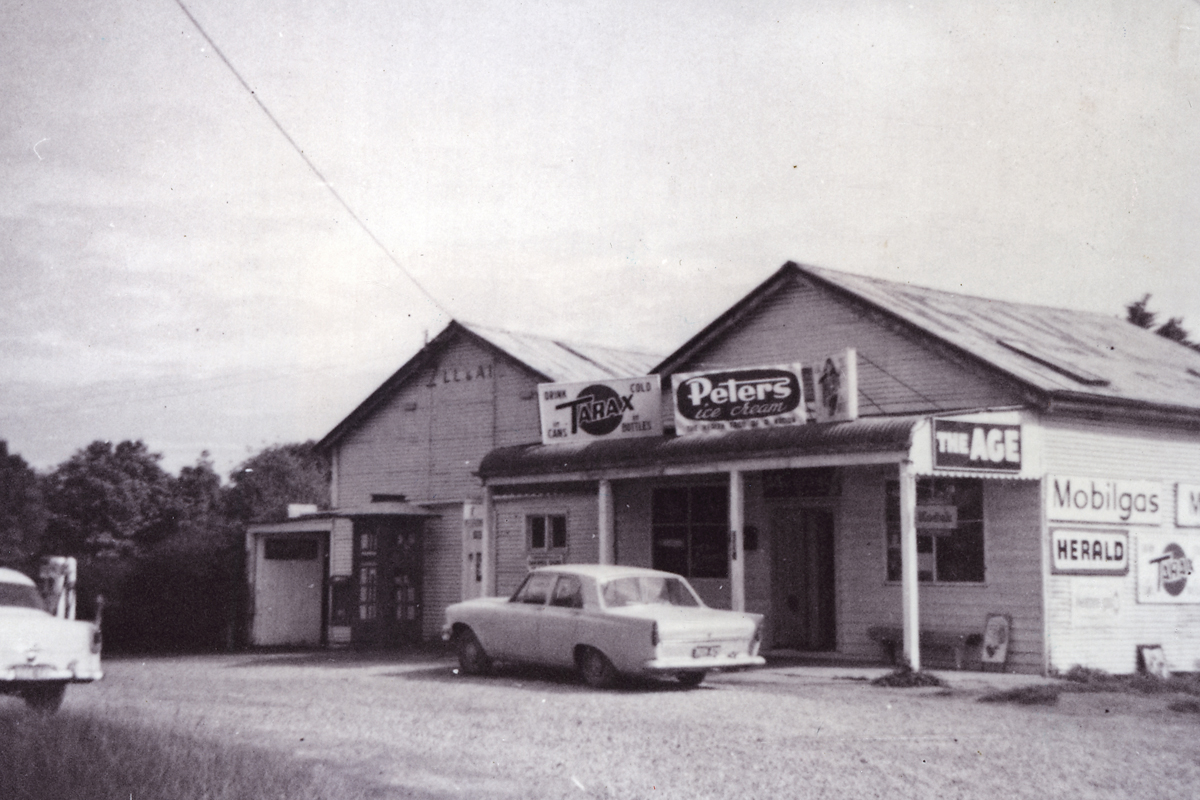
The store at Merricks Beach
There was also the smaller store at Merricks Beach three kilometres away. Prior to World War II that store opened as a small store/cafe at the beach run by Jack and Ella Wallace. Then George Weston, Alf and Tilly’s son, ran it when he was 16 as an extension of his parents’ store. It sold newspapers, groceries and handled mail. George was too young to have a driver’s licence but the Cole family, who owned the land between the beach and the Merricks Store, allowed him to drive through their paddocks. A new building was erected at the beach by the Westons in the late 1940s. It carried a limited range of items and was open mostly at certain hours during the summer holidays. It was on the same lease as the Merricks store and the same leaseholder was responsible for both.
After thirteen months during which there were three robberies – two at the Merricks Store and one at the beach store – the McWhinney family decided to leave. The leasehold was sold back to Mrs Weston in 1965.
Back in Weston hands
Tilly suggested to her younger son John that the Westons might again take over running the general store. John was now married with a young family. He had worked for the lighthouse service and the family had recently returned from Wilsons Promontory. His wife, Marlene “jumped at the opportunity” on the condition that they could stay until their children finished school. Neither the store nor the house had been well maintained and John did considerable work upgrading the premises before the family moved into ‘Westgate’. He put in new petrol bowsers and rebuilt the small garage at the side of the shop. John restocked a number of supplies that had dropped off whilst the store was leased. Once again it became a fully functional store selling a wide range of goods and produce. John drove to the market to get supplies and produce; once a week for groceries and twice a week for fruit and vegetables. These trips involved an early morning start. Back at the store, bulk-bought goods were weighed and placed into brown paper bags. Biscuits came in big square, tins. Eggs were sold individually by weight. Marlene worked in the store all day after the children left for school, taking over from John who had opened earlier for the newspapers. Margaret Stone worked a few hours to relieve Marlene. The store’s hours were extended until eventually it opened at 6.00 a.m. and closed at 6.p.m. seven days a week. Point Leo was growing in popularity as a surfing destination. With the increase in traffic on the road there was a growing demand for take-away food. The store sold sandwiches and hot dogs.
Tilly again ran the post office. Her grand-daughter Sherrill recalls that “she loved her work as postmistress and took her role seriously. She was always punctual and well-dressed in tailored suits and pearls. In the summer she wore spotted dresses”. Marlene later took over from her mother-in-law who still came in occasionally until her death in 1975.
During their time there were no burglaries but perhaps an attempted one. They owned a large dog called Ben and each night John locked Ben inside the shop for security. One morning blood was found on the floor among shards of glass from a broken skylight. Had Ben foiled an attempt?
The Westons finally sold the business in 1976 when their youngest daughter (Donna) turned 17.
The Morgan family takes over
The new owners were Leigh and June Morgan who ran the store for two years. Leigh had known Merricks from the time he was five and the couple had been frequent visitors to the area. Leigh had held an engineering position but was recovering from cancer when he and his wife took over. They continued to run it as a general store. The Westons stayed on for a time to help ease the transition with John continuing to drive to the Victoria Market to collect the supplies. June Morgan attended to the bank and post office. It still remained the hub for the local community but, especially in summer, visitors outnumbered the nucleus of local people. Situated on the highway, a steady stream of people stopped to buy drinks, refreshments and incidentals. At weekends ice-cream and canned drinks disappeared rapidly.
The store’s buildings were spacious enough to allow different businesses to set up shop. Surfboards were sold and a craft shop, ‘Country Matters’, opened. An antique shop occupied an area for a time as did Coora Cottage Herbs.
June had three small children to look after and when Leigh returned to engineering, running the store became too much. They leased the business to a relative, Lloyd Gillies. Lloyd saw the potential for fast food and began to sell mainly hamburgers to the surfing crowd who frequented the store at weekends and during the holidays.
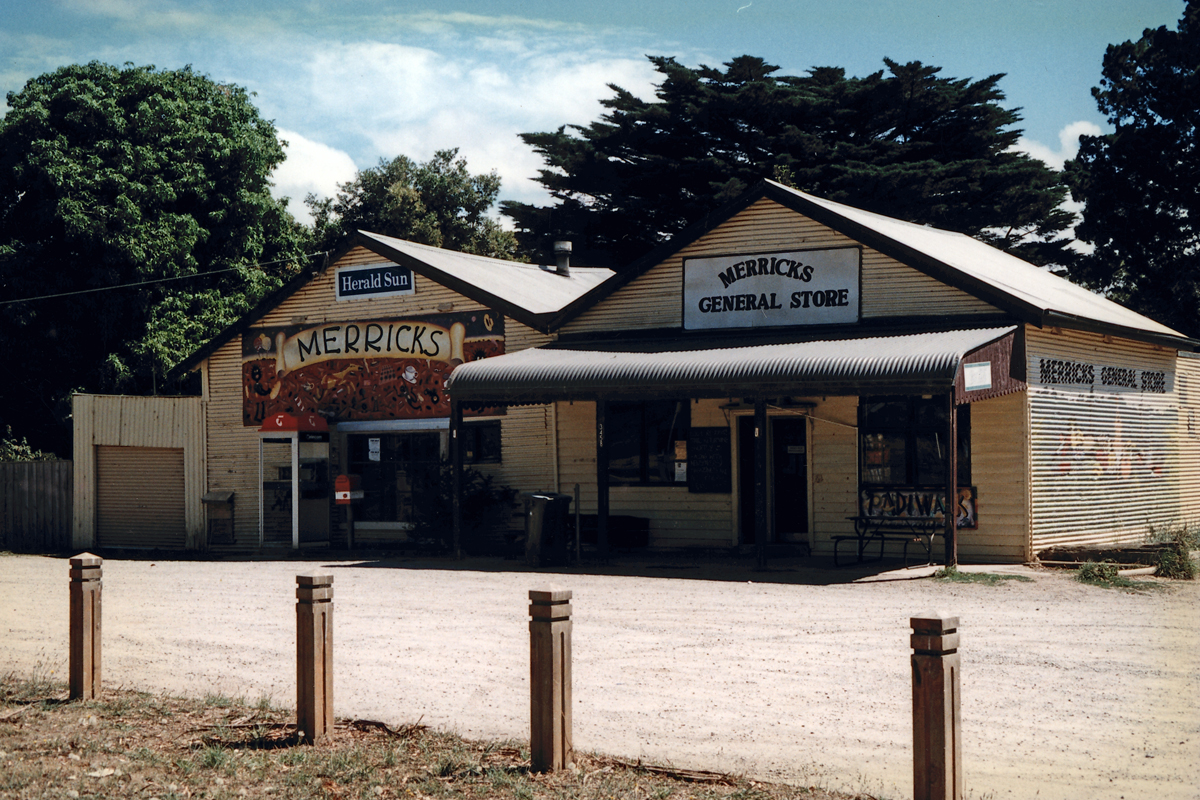
The Surfers’ Haven
Nola Coulthurst took over the lease in 1979. Her first morning was unforgettable. The first person through the door was the Heath Inspector who had come to close down the store. The main problem was the floor. In Nola’s words, “there were bare boards everywhere with a strip of grotty, ancient lino behind the counter”. Nola was given a second chance and when the inspector returned a week later, he was satisfied with the changes she had made; bare boards scrubbed clean and the old lino replaced. The store still offered a wide range of items but the postal department reduced its services during her tenancy, leaving just basic services such as postal orders. It remained an agency for the Commonwealth Bank. Nola remembers Phyllis Cole, a regular customer and treasurer of St Mark’s church arriving with her “very old, voluminous and musty handbag” which she emptied onto the counter. The collection money, mostly coins, took Nola hours to count. Nola extended the range of ready-made foods, introducing pork pies, quiches, sausage rolls, scotch eggs. The food was incredibly popular. As the store had no cooking facilities she brought a plug-in stove from home. She also inherited a jaffle iron and a grill plate.
Friday nights at home were spent baking in preparation for the weekend. Merricks Store sausage rolls were legendary. One of the store’s main problems was rodents and they could often be seen moving behind the hessian-covered walls. Liz Dart, who ran ‘Country Matters’, set up a window display that included sheaves of wheat and the rats had a picnic. Baits were laid and eventually rats were eliminated. The store at the time had a pot-bellied stove which was very popular with the surfers when they came in from Point Leo, “frozen cold, with numb hands and numb feet”. They would get as close as they could to the fire and Nola could sometimes detect what smelt like burnt flesh as she prepared their jaffles. The uneven floor presented a problem. When people walked across it the shelves moved as the stumps were not sound. Nola worried that the weekend tourists who found the store “so-o-o quaint might be in peril of the floor collapsing beneath them”. Nola held the lease until 1981,
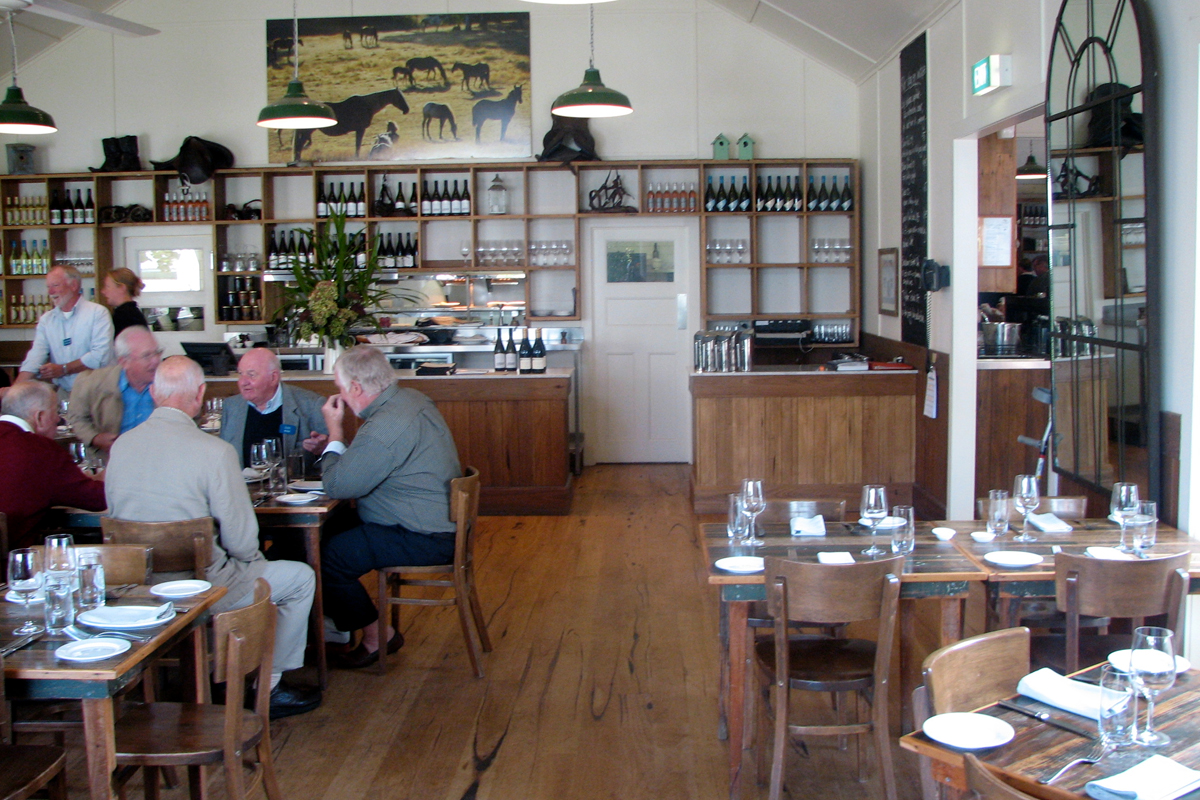
Changing fortunes
Throughout the next decade she was followed by a succession of people, Marjorie and Brian Parker, Robyn Cornish and Lyn Walker, Denis and Sonya Hanlon, Mr Maher then an artist named Bill Millerick. In 1997 Richard and Eunice Herr took over the store and revitalized it as a restaurant and meeting place. Richard was a caterer in the city but their interest waned and they moved on. Hayley and Melanie Morgan, daughters of the owners, took charge for the next few years. But the buildings were old and ramshackle and business had fallen off. In 1979-80 a new shopping complex, including a supermarket, had opened in nearby Balnarring. It was a death knell for the small, local, general stores. Custom became mostly mail and newspapers and catering.
Transformation
Finally in 2002 the old store was auctioned. It was bought by Dr Damien Ireland and his wife Sue, Michael and Mary Calaban and Ian McCrae who promptly closed it down and planned extensive renovations. For almost three years the building remained shrouded while planning and construction went ahead. During this time there was a degree of unease in the Merricks community, as to what would emerge. A newssheet “Local Talk” was distributed periodically to keep people informed. The Irelands wanted to restore rather than demolish. They engaged architect Charles Steinic and local builder Garry Keirnan to undertake the alterations. The floors walls and stumps of the old building were rotten and the interior had to be gutted but the façade and the end wall of corrugated tin were retained. The new design kept within the old footprint and material was re-cycled where possible Tables for the new restaurant were made from the original floor boards. The result was a building that gained the award of Architectural Excellence in the South East for the Best Building Conservation (Commercial). The store re-opened in December 2004 as a café for fine dining, an outlet for Rigel wines from the Calman’s vineyard at Shoreham and a small store selling local products. It quickly became a popular venue all year round with its outdoor deck in the summer and large two-way open fireplace in the winter.
The property changed hands in 2008 when it was sold to the Myer and Baillieu families of the nearby Elgee Park and Baillieu vineyards. The store became a centre for wine tasting and sales instead of cellar door trading. Kathleen Queally of Balnarring Vineyard was also a part owner of the business side of the venture although she sold out in 2014. Laurence Tedesco had been appointed manager. The store gained an excellent reputation as a venue for wine tasting and fine meals served throughout the day. With its several separate eating areas it could accommodate special functions or a quick cup of coffee and a snack. Before his death early this year owners, Bails Myer and his wife Sarah, were rated by the staff as their best customers. The adjoining house ‘Westgate’, originally the Weston family’s home, was converted into a gallery in 2012 where works of art were displayed. The conversion again was acclaimed, winning a Mornington Peninsula Heritage Award.
Today’s complex of buildings shaded by the magnificent kurrajong tree has a quaint, old-world appeal. Merricks General Wine Store remains a popular hub albeit of a different nature from the general store that opened its doors a century ago. This milestone was celebrated by various events held during October.
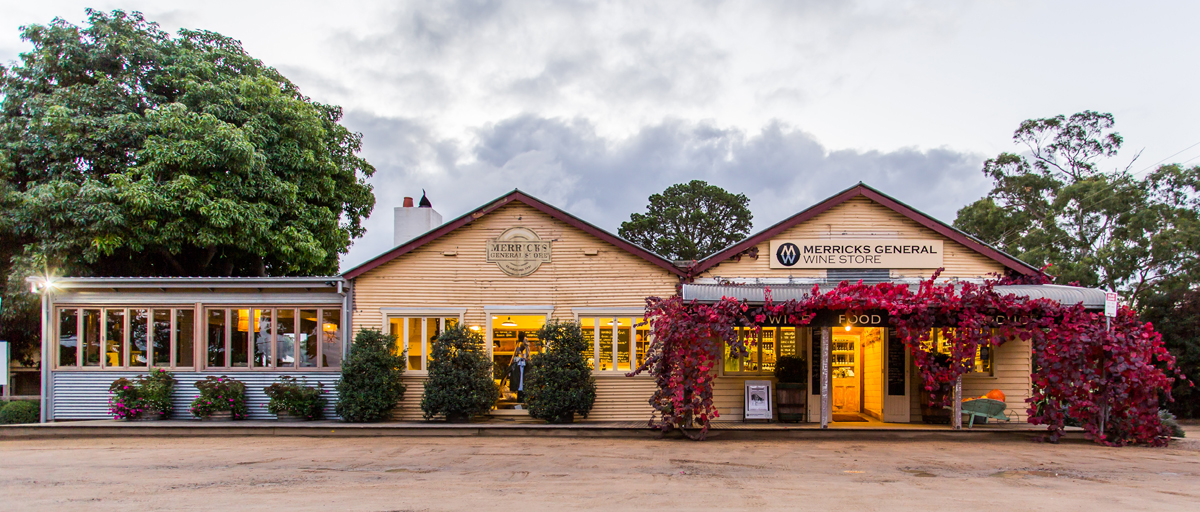
References:
Interviews and written recollections of Marlene Weston, Peter McWhinney, Nola Coulthurst, Leigh Morgan (BDHS archives)
Newspaper articles (BDHS archives)
Bruce Bennett: The Old General Store also Merricks General Store, a History
Ilma Hackett: Merricks Store Scrapbook





